The post-WWII career of USS Killen (DD-593) is an interesting example of how the USA’s Cold War atomic tests, along with sloppy record-keeping and the unavoidable passage of time, resulted in a public relations mess at the turn of the millennium.

(USS Killen at sea in the Pacific during WWII)

(Wreckage of USS Killen on the Caribbean seafloor in the 21st century)
USS Killen was a Fletcher class destroyer, a very capable WWII design later overshadowed by the Sumner and Gearing classes. During the early and middle stages of WWII, the Fletcher class were the US Navy’s go-to destroyers; and performed excellently in all roles in both the Pacific and Atlantic. The Fletcher class displaced 2,050 tons and was armed with five Mk30 5″ guns, two quintuple tube launchers for Mk15 anti-surface torpedoes, two depth charge racks, and 40mm and 20mm anti-aircraft guns. They were designed for sonar and radar from the outset, and were very fast (38 kts). As WWII went on, the Fletcher class was constantly upgraded with newer radars and communications gear, and additional AA guns to combat kamikazes. By any WWII measure, these were high-quality destroyers.

(USS Killen at sea during WWII.)
USS Killen during WWII
USS Killen was built at Puget Sound Naval Shipyard and launched on 10 January 1943, commissioning on 4 May 1944. During WWII, USS Killen participated in the Leyte Gulf and Borneo engagements. For certain the ship’s claim to fame came during the Leyte Gulf battle, when USS Killen fired a spread of five Mk15 torpedoes at the battleship IJN Yamashiro, scoring at least one direct hit.

(USS Killen’s commissioning. The two quad-packs of cylinders between the depth charges are Mk4 smoke-screen generators, a technology about to go obsolete as radar became common during WWII.) (photo via navsource website)
USS Killen after WWII
USS Killen was operating with the US Navy’s North Pacific Force, covering the area inbetween Alaska and northern Japan, when WWII ended. On 9 September 1945, USS Killen escorted the command ship USS Panamint (AGC-13) to take custody of the Imperial Japanese Navy base at Ominato on Honshu.
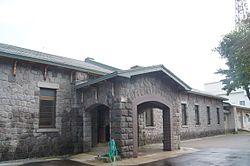
(This building of the former Imperial Japanese Navy at Ominato was used by the US Navy during the occupation. As of 2017 it still exists.)
USS Killen supported the occupation flotilla in Japan until 14 November 1945 when the destroyer returned to the United States. It was decided that USS Killen not be kept in active service and on 2 April 1946, USS Killen transferred to San Diego, CA where the crew was allowed to “draw down” as WWII enlistments ended. On 9 July 1946, USS Killen was decommissioned and placed into mothballs.

(USS Killen in mothballs in June 1950.)
radioactive contamination of former WWII warships
To understand some of the later drama of USS Killen, the story of USS Independence (CVL-22) is useful. This WWII aircraft carrier was one of the target ships for the 1946 Crossroads nuclear tests at Bikini atoll.
USS Independence was damaged by both the Able and Baker detonations, and massively contaminated by fallout from Baker. At the conclusion of Crossroads, the US Navy towed the ex-USS Independence to California to serve as a decontamination test hulk.

(Tugboats move the smashed and radioactive hull of USS Independence around San Francisco harbor.)
Radioactivity was poorly understood in 1946. There is no “fix”, “antidote”, etc. Unlike contamination from chemicals, infectious germs, smoke, and the such; there is no way to neutralize radioactivity. The only thing that lessens it is time, and there is no way to speed up the process. At Bikini, decontamination of the damaged target ships was attempted by mopping the decks, which did nothing, and then by hosing down the ships with lagoon water (itself radioactive) which only made the problem worse.
In San Francisco, the US Navy threw pretty much every idea in the book at the contaminated ex-USS Independence. No sort of cleansing worked, the only tactic with any relief (and itself, nowhere near complete) was to sand down contaminated surfaces to bare metal. This expensive process simply “moved the problem” as the ground-off dust remained radioactive until time wore it off.
In 1951, the US Navy gave up on the ex-USS Independence. At the time, radiation aboard was still 60,000 μRem/24h, or roughly the equivalent of an x-ray every day. It was decided to use the WWII warship as a sarcophagus for Crossroads. The carrier’s empty tanks were filled with liquid nuclear waste products from the post-test studies and experiments. Next, Hunters Point shipyard (working in timed shifts) stripped out the propulsion systems. Radioactive plants and fish from 1946 were loaded into the former engineering spaces, as were oversized items taken from other target ships in 1946, the largest being a 6′-long length of 6″ steel pipe. Finally, all of the radioactive dust from the grinding of the carrier itself was loaded into 55 gallon steel drums, as was the grinding discs, worker gloves, mops, and other miscellaneous Crossroads detritus like sample bags, uniforms, contaminated lab equipment, and the such. The 55 gallon drums were then topped off with concrete and sealed. There were over 100 drums on the ship; an exact count was not made.
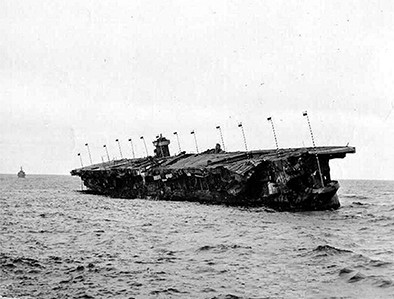
(The ex-Independence being scuttled in 1951.)
In late January 1951, the ex-Independence was towed to 2,600′ water about 30 miles west of the Golden Gate Bridge and scuttled.
USS Killen and Hardtack I
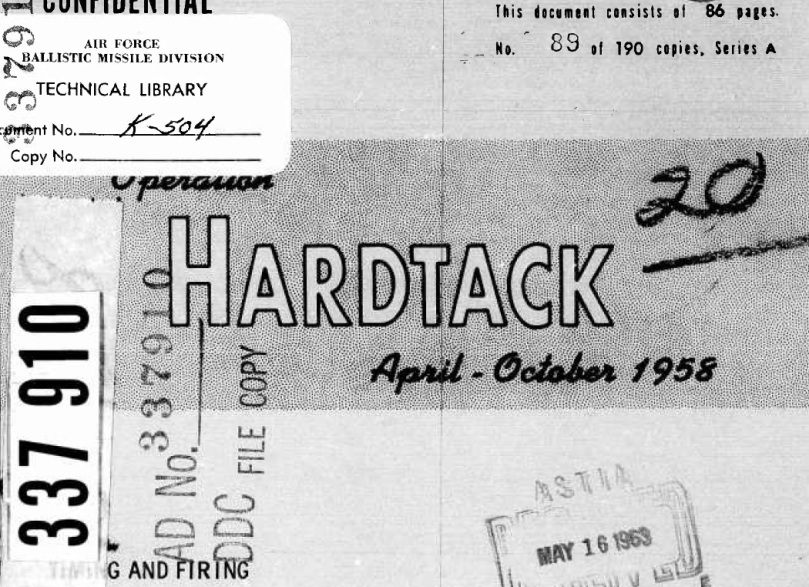
Hardtack I was the codename to a series of 35 nuclear weapon tests conducted during the summer of 1958. Each test had it’s own secondary codename. A variety of weapons were tested, in various settings: mid-air detonations, surface blasts on the ground or on barges, and two underwater tests, Hardtack Wahoo and Hardtack Umbrella, at Enewetak Atoll in the Pacific.

For these two tests, the US Navy’s Bureau Of Ships (BuShips) was assigned to find targets and picked four WWII vessels: S.S. Michael Moran, a civilian Liberty Ship freighter built in 1944; and three Fletcher class destroyers, the ex-USS Killen (DD-593), the ex-USS Howorth (DD-592), and the ex-USS Fullam (DD-474). All of these ships had been placed into layup after WWII. S.S. Michael Moran was the property of the US Maritime Administration (MARAD), while the three destroyers were mothballed in the Pacific Reserve Fleet Group.
None of the three destroyers chosen had been reactivated during the 1950-1953 Korean War, none had received radar upgrades since WWII, and by the later part of the 1950s the US Navy felt it was unlikely they would see further use. The selections were by no means secret and openly reported by the Long Beach Independent newspaper.
Here, the term “target” is misleading, as unlike the 1946 Crossroads tests at Bikini, the Hardtack tests were not hoped to sink the ships, rather, it was desired that they all survive so that test effects could be studied in detail.
To prepare USS Killen for Hardtack, Long Beach Naval Shipyard restored the destroyer to a representation of operating condition. This was not the same as recommissioning the ship; it would obviously be unmanned and need only be restored to the degree of simulating actual use.
One thing the US Navy wanted to study was the effect of an atomic detonation’s shock wave on WWII-era steam turbines and reduction gears, in the presence of centrifugal force on the blades and gears from them spinning in motion as the blast happened. Only one side of the Fletcher class’s split plant was needed to accomplish this test. This would require the whole starboard propulsion lineup (including the propeller shaft) to be in use when the bomb detonated. As the ex-USS Killen would be unmanned, and had to remain stationary, this presented a problem. The solution was removing both of the destroyer’s propellers, and on the starboard shaft, installing a flat metal disc of appropriate weight. This would allow the shaft to spin without generating any forward thrust. It would also allow the destroyer’s motorgenerators to be operating and provide electricity to the test equipment the US Navy was to install.

The location of the various shock sensors and radiation detectors is shown above. A total of 130 pieces of test equipment of various types was installed on the ex-USS Killen. An interesting piece of 1950s technology were wire strain gauges, these had small lengths of precision-cut wire affixed directly to the steel hull of the ex-USS Killen. After the test the “new” length of the wire would reveal how much the hull had flexed.

The US Navy also installed video cameras to record how the blasts would effect onboard equipment. Typically they were installed in pairs as shown. The lead protected the film from being ruined by high radiation.
A major change to USS Killen‘s WWII hull was the addition of a NBC washdown system. This post-WWII technology (still in use aboard 21st century US Navy vessels) is an array of small sprinklers on the deck and superstructure. Makeshift NBC washdown gear was installed on all four target ships.

(The makeshift washdown system aboard the target Liberty Ship being operated prior to Hardtack I.)
A NBC washdown system is preemptive decontamination used before an expected enemy nuclear detonation. The system coats the ship’s surfaces with clean, uncontaminated seawater. When fallout then arrives, it bonds with the standing clean water instead of the ship’s steel, and then drains away along with it. Despite it’s name, a washdown system is less effective to clean radioactivity already on a ship, as the seawater in the ocean around the ship would be contaminated as well. This was one of the lessons learned in the 1946 Crossroads tests, where the US Navy tried to decontaminate WWII warships like Prinz Eugen and USS Nevada by hosing them down with radioactive seawater from Bikini lagoon. This had no effect and only intensified the problem.

(The technology in a modern setting, here aboard USS Ronald Reagan (CVN-76) during an exercise.)
It took Long Beach Naval Shipyard four months to make the ex-USS Killen and the other two WWII destroyers ready for the tests. They were towed to Enewetak by the armed icebreaker USS Staten Island (AGB-5).
Hardtack Wahoo
Wahoo was a deepwater shot to study the effects of using nuclear weapons in the anti-submarine (ASW) role. Thirteen years after WWII Germany’s u-boat menace had been defeated, the Soviet navy was in the midst of a massive submarine expansion and NATO was keen to use atomic weapons in any future Atlantic convoy battles.

(USS Grasp (ARS-24), a WWII-veteran salvage ship, transported the nuclear device.)
Use of nuclear weapons in ASW had an obvious limitation: the submarine had to be close enough to be within sonar range to be targeted, but, still far enough away that the nuclear blast would not also sink the destroyer itself. The effective range was thus like a “donut” rather than a range circle. Wahoo sought to refine the safe limits of the “donut”.
A secondary goal of both Wahoo and Umbrella was to explore the use of atomic weapons in minesweeping. For this, a field of WWII-surplus naval mines was laid around Enewetak. It was considered that possibly, in a future war minesweeping might be accomplished by carrier-based aircraft dropping endless low-yield nuclear weapons ahead of a task force. This was by no means the most zany scheme the US Navy studied in the late 1950s; another idea was to use chains of nuclear blasts to gouge out canals across an isthmus or peninsula.

(The Wahoo device’s capsule (the black object) prior to being submerged. The WWII-surplus landing craft attached to it was the floating “trigger”.)
Wahoo was a very difficult test to stage. The “device” was the extracted core of a Mk7 bomb, modified to fit in a pressure-tight capsule. It was suspended by underwater telephone cables at a depth of 500′. The predicted yield was 9kT, only 42% of the Nagasaki blast during WWII. The device was suspended beneath a WWII-surplus landing craft, which also carried the radio trigger antenna array. To study the test, a complicated array of buoys called coracles was laid, in addition to the mines and four target ships.

All of these things had to be moored in deep water (as much as 3,200′), in varying currents. A directive was that a sustained southwesterly wind had to be present at the blast time to ensure no fallout reached Hawaii, further complicating the planning.
The conditions were met in the afternoon of 16 May 1958. A series of sounding rockets was fired off the atoll; their smoke trails would allow visual observation of the shockwave. The ex-USS Killen‘s starboard propulsion plant was in cruising mode, with the starboard shaft (and attached disc replacing the propeller) spinning at 397rpm. The destroyer was positioned 180° towards the blast, about 1¼ miles away.
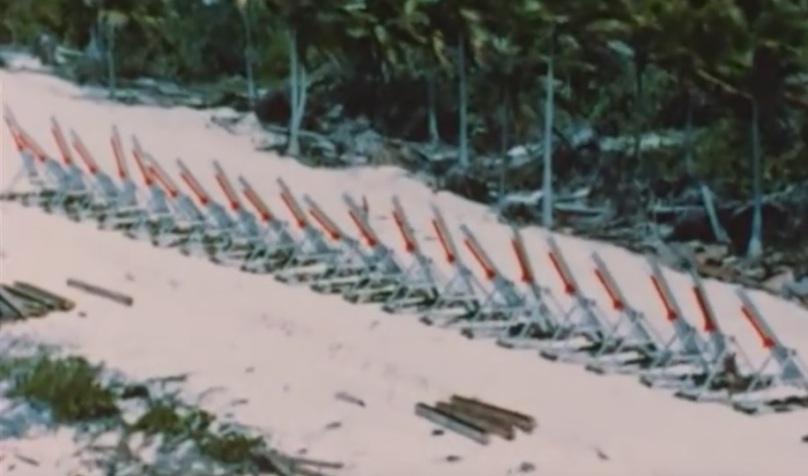
(Sounding rockets ready on the atoll.)
At 13:30 local, the device detonated as planned. The yield was estimated at 9kT. The 500′-deep detonation briefly turned a section of the ocean orange, then emitted a column of seawater and steam 840′ tall.

(The fireball underwater at 1 second after detonation.)

(The huge water column breaking the surface several moments later.)
As predicted from the Crossroads Baker test in 1946, this settled into the base surge, a rolling wall of seaspray that moved at 100fps out to roughly 1¼ miles, after that it rapidly slowed down and was more or less dependent on wind to keep it going.

(The ex-Killen (right) after the shock wave passed but before the base surge arrived. The black puff from the forward stack is soot jolted loose by the shock wave, visible by the white line advancing across the water.)
What is called “free-field Γ ” (gamma radiation in the general area, not specific to any fallout) dispersed enough by T+15 minutes that the area could be safely (by 1950s standards anyways) re-entered by small boats or aircraft. As expected, the radioactivity on the target ships superstructures was much more intense due to the base surge, as much as 6x. However because of the relatively low yield and the depth of the detonation, the surface radiation already fell by 25% within T+1 hour 45 minutes.

(Radiation aboard the ex-Killen rose rapidly at T+2 minutes as the base surged settled onto the WWII ship’s deck, then climbed again at T+3½ minutes as airborne radioactivity arrived, then started to level off at T+6 minutes.)
The ex-USS Killen was the least damaged ship, and the only one with radioactivity low enough to reboard on the day of the test. As expected, the Liberty Ship (which was roughly a ½ mile from ground zero, facing it broadside) fared the worst, with the hull plating facing the blast distorted inwards about ¾”. The US Navy was only able to obtain a full set of test parameters off of the ex-USS Killen, as the other two WWII destroyers (which were closer to ground zero) had their internal electrical wiring severed before the test instruments aboard could register results.

(The experienced shock against some of the ex-Killen’s systems from Wahoo, both directly and from the shock wave rebounding off the seafloor. Some of the items were heaving, for example a +4G movement one way then -1G the other within 13 milliseconds. This heaving motion was more troublesome than one stronger jolt.)
Overall the Wahoo blast produced much less severe damage than had been predicted. Aboard the ex-USS Killen, damage was very minor.
Hardtack Umbrella
Umbrella was a shallow-water blast inside the atoll’s lagoon. The goals were the same as Wahoo, but to study the effect of differing depth. A secondary objective was to follow up the 1946 Crossroads Baker test, which had produced many unexpected phenomenon which the US Navy was unprepared to study at the time. A Mk7 bomb was used, set at 150′ depth. The same four target ships were used, as only the Liberty Ship had taken any appreciable damage during Wahoo.

(The ex-Killen’s NBC washdown system being operated prior to the Umbrella blast.)
The bomb was detonated at 23:15 local on 8 June 1958, with a 8kT yield, slightly less than expected. The water column reached as high as 5,000′, meanwhile a 20′-deep crater a ½ mile in diameter was gouged out of the lagoon floor. The blast created a small tsunami which briefly covered the atoll with several feet of water. Much like the Wahoo test, the ex-Killen took the blast stern-first, and out of the four ships, received the least damage.

(The ex-Killen’s position, furthest away from ground zero. The magic marker streaks redacted the exact ranges prior to the map’s declassification.)

(A fairly famous picture, this image of the Umbrella blast shows the S.S. Michael Moran silhouetted against the seawater column. The smoke trails are from the sounding rockets fired off the atoll.)
Compared to the radioactivity nightmare at Bikini in 1946, the contamination produced by the Umbrella test in 1958 was much less, for several reasons. To begin with the Umbrella blast was 66% weaker, and 60′ deeper in the water. Whatever it’s limitations, the makeshift NBC washdown rig did work to a degree. Finally, some Crossroads target ships, like USS Pennsylvania or IJN Nagato, were already in rough shape with unrepaired WWII damage; while the ex-Killen had just been to a shipyard prior to Hardtack.
final conclusions of Hardtack and the Fletcher class
The primary concern of an underwater nuclear blast against WWII-era destroyers was found not to be hull damage as expected, but rather the jolt damaging internal machinery.
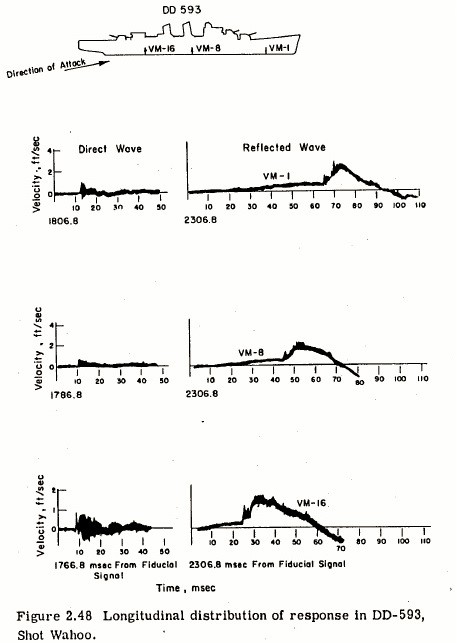
(The absorbed shock aboard the ex-Killen, measured in three spots on the hull. The secondary wave, rebounded off the seafloor, was actually more damaging as it hit the whole length of the flat underside, while the first wave struck only the stern.)
Another lesson learned was that the range differences resulting in light, or fatal damage to a ship were very narrow…for example, the ex-USS Fullam had the flex plate bolts on the in-use turbine damaged by the Wahoo shock wave. If the destroyer had been only slightly closer the bolts would have sheared completely and the still-spinning turbine would have dropped through it’s housing into the bilge, destroying the ship. As it were, the range was just enough that not only did that fail to happen, but the turbine kept running normally.
The listed cost of the two tests was $10.4 million ($87.7 million in 2017 dollars) which didn’t include the value of the four ships, nor the two atomic weapons.
After both blasts, the ex-Killen received a basic cleaning from the WWII-veteran salvage tug USS Bolster (ARS-38). The method used was a concentrated detergent with uncontaminated water. USS Bolster‘s logs did not mention anything notable about the ex-Killen; however they state the ex-Fullam took two days to cleanse.

(USS Bolster, which had a long career in the post-WWII US Navy.)
The damaged Liberty Ship was judged not worth towing and sunk by gunfire. The three destroyers were towed back to Pearl Harbor, HI. The ex-Howorth and ex-Fullam were both expended as torpedo targets in 1962. This left the ex-Killen.
USS Killen after Hardtack
After a brief stint pierside in Pearl Harbor, the ex-Killen was towed to the Naval Radiological Defense Laboratory in California in 1958. It was here that the WWII ship’s history gets murky.
The ex-Killen was kept at the NRDL for at least two, but not more than three, years. The NRDL was apparently studying how low-level radioactivity decayed off a ship with no additional efforts. None of these reports, if they exist, have ever been declassified.
When the NRDL was done with the ex-Killen, the ship was towed through the Panama Canal and then up to Virginia. The date of the tow is uncertain. However it was no later than early 1962, because during the middle part of that year, the ex-Killen was used in underwater explosive shock tests off Chesapeake Bay. The purpose of these tests were to simulate a scaled-down version of a nuclear blast, as public opinion was already souring on the seemingly endless atomic tests releasing fallout into the atmosphere. It was hoped that by using mathematical formulas, the results of the tests could be dialed up or down to simulate atomic weapons. It’s unclear if this scheme had the desired outcome.
Possibly at this time, the WWII 5″ gun turrets and some of the superstructure were removed. An ideal setup for a ship involved in tests of this type is to lower the centre-of-gravity, by lessening weight topside and compensating by adding ballast beneath the waterline. Lowering the centre-of-gravity lessens the odds of the ship capsizing from lateral or oblique forces above the waterline, or from asymmetric flooding below it. On the other hand, the structural lightening may have already been done at the NRDL, or, done later in Puerto Rico. There are apparently no records in the US Navy of the job.

(The ex-Killen in 1970, showing how the hull had been stripped down by that time.) (photo by Jim Babin)
In January 1963 the ex-Killen was listed as surplus to Atlantic fleet requirements. On 1 June 1963, the ex-Killen was formally stricken off the US Navy’s inactive rolls. The WWII destroyer was, at some point that year, allotted to the US Navy base at Roosevelt Roads, PR, for use as a target at the Vieques gunnery range. It’s unclear exactly when (one source lists it in April 1963, before the hulk had been formally stricken) or by what paperwork route.
As the main Vieques target hulk, the ex-USS Killen replaced the ex-USS Barr (APD-39), a WWII escort converted into a fast transport then decommissioned after only 2½ years of service. The ex-Barr was used a a target until March 1963, when it could not absorb any more damage.
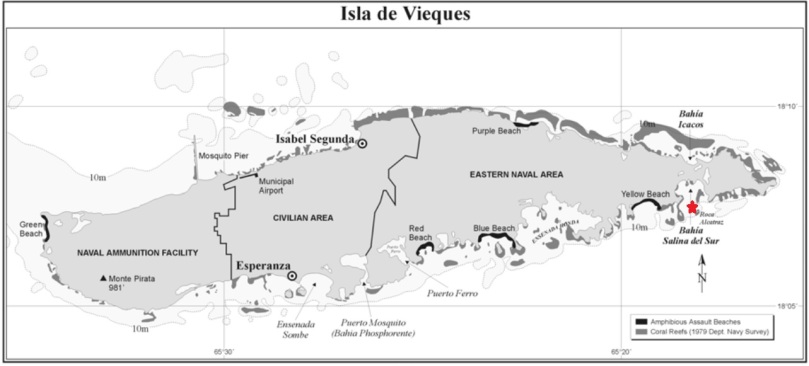

Vieques is a small island east of Puerto Rico. From WWII until 2001, it was a sub-facility of the larger Roosevelt Roads base on the main island. The west end of Vieques held a naval support station, the center remained inhabited by civilians, and the east was an expansive sea-air-land firing range, complete with moorings for target ships, a dummy airstrip, and a mock Soviet SAM instillation. Over the decades, everything from WWII battleship shells to Vietnam-era machine guns to Desert Storm-era missiles were dropped, shot, or fired at or around Vieques.
When the ex-Killen was not being shot at, it was moored at Roosevelt Roads naval station on the main island of Puerto Rico, being towed back and forth as needed.

(Taken in February 1970, this photo shows how the hulk’s anchors had been removed. In their place, a reinforced towing chain attachment was installed.)

(The battered ex-Killen pierside at Roosevelt Roads in 1975. Ahead of the mounting ring for the removed aft 5″ turret is a parabolic mesh used to magnify the hulk’s radar signature.)
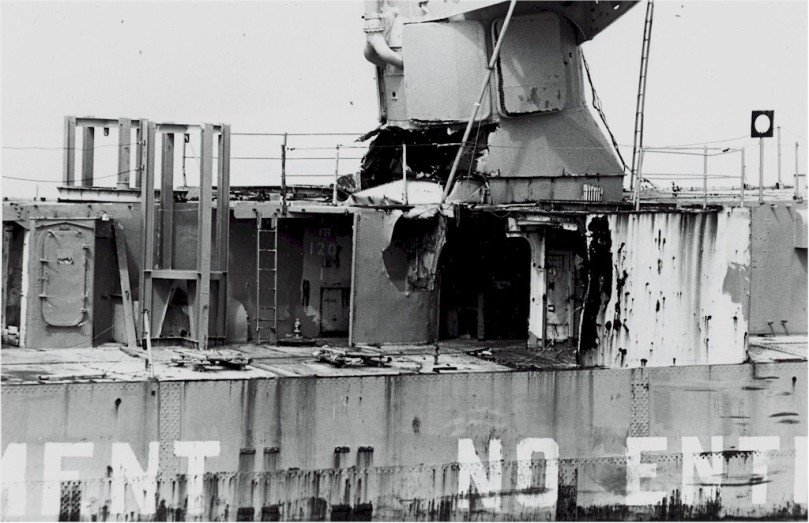
(The hulk’s condition in February 1970.)
Andy International
It’s highly probable that a company called Andy International was involved with the ex-Killen in Puerto Rico. Headquartered in Brownsville, TX; Andy International was formed in 1970 almost specifically for scrapping or scuttling the US Navy’s inventory of WWII warships, still sizable at that time.
During the 1970s, Andy International had a small office in Miami, FL which itself subcontracted work (both scrapping and salvage) to Puerto Rico. The subcontracted Puerto Rico-based companies were often “mom & pop”-type setups.
On 16 April 1975, a government accounting entry was made invoicing $38,666 to Andy International’s Miami office, for the rights to cut up on-site a target destroyer at Vieques. This would to have had to been only the ex-Killen. In all likelihood, Andy International in turn immediately resold the rights to a local scrapper.
Obviously the ex-Killen was not cut up on site, as it’s wreck sits on the Caribbean seafloor today. There is no firm answer as to why. One theory is that the local scrapper removed whatever was easy to remove, then disposed of the rest by scuttling it off Vieques. Another possibility is that they intended to move the hulk to the main island of Puerto Rico, but lost the tow and had the hulk founder. If the tow was uninsured, there would have been no incentive to document the loss.
Andy International ceased operations in 1982, with the Miami office having closed even before that. The modern shipbreaking juggernaut Esco Marine Inc. in Brownsville partially sits on what had been Andy International’s grounds, so not only is the corporate entity gone, but some of the buildings itself are physically no longer around. Presumably any documents inside them went to a landfill long ago.
the end
No records at all, at least in the unclassified realm, were kept regarding the ex-Killen‘s activities between the mid-1960s and mid-1970s.

(The ex-Killen in the early 1970s.)

(This photo was taken in the aft deckhouse, looking out towards the starboard side.)

(Looking up and rearwards at the aft smokestack through a weapons hit hole, this photo is directly underneath where the forward Mk15 torpedo tubes had been in WWII.)
There was usually no real reason for active-duty warships to note the past history of a target hulk, so very rarely did USS Killen‘s name come up. One entry in the 1969 log of USS Wainwright (CG-28) recorded that it had struck the ex-Killen with several RIM-2 Terrier surface-to-air missiles being fired in the secondary anti-ship mode.

By 1975 the hulk was in very poor condition and barely safe to tow back and forth.

The photo above shows five black 55 gallon steel drums set pyramid-style where the bridge had once been. These baked in the Puerto Rican sun and magnified the hulk’s infrared signature against heat-seeking weapons. The big screen behind them aided in visually acquiring the hulk.

As seen above, by 1975 repeated bomb, missile, and gunfire hits had caused both smokestacks to topple over, along with part of the high-contrast screen. Despite being stripped down, the hulk is still riding a normal draught, possibly indicating it was being ballasted internally.
The final recorded act of the ex-Killen was “recorded as scuttled” on 15 April 1975, in Bahia Salina del Sur off Vieques. This bay was one of several US Navy restricted areas at the time. The US Navy itself, apparently, did not do the scuttling; but rather just took note that it had happened.
As personnel at the base turned over, memory of the target hulk rapidly faded. By the time of Ronald Reagan’s first term in 1980, charts provided to warships using the gunnery range showed the location of the “ex-DD-593” wreckage and also a second wreck, usually just called “barrel barge” on account of it being shaped like a barge and filled with 55 gallon drums. Otherwise, the wreckage’s history and condition were apparently of little interest, and unknown.

(Location of the ex-Killen and the “barrel barge” several hundred feet away.) (map via Geo-Marine)
the barrels
The most obvious feature of the ex-Killen wreck is hundreds of steel barrels strewn about. Estimates of the total varies, the most common is 200, but if individual pieces are counted they number between 900 to over 1,000. They are common 55 gallon steel drums. Almost all are imploded open, missing their covers, crushed, punctured, etc; however some are still sealed and intact. Most have seafloor silt ingressed onto or into them.


As public concern against the US Navy exercises in Puerto Rico mounted in the late 1980s and early 1990s, local divers made unauthorized visits to the wreck and saw the barrels. Naturally, the absolute worst was feared….that in 1958, radioactive waste aboard the ex-Killen was simply loaded into the drums, put inside the ship, and forgotten about. Considering the situation of the ex-Independence this fear was not altogether unfounded.
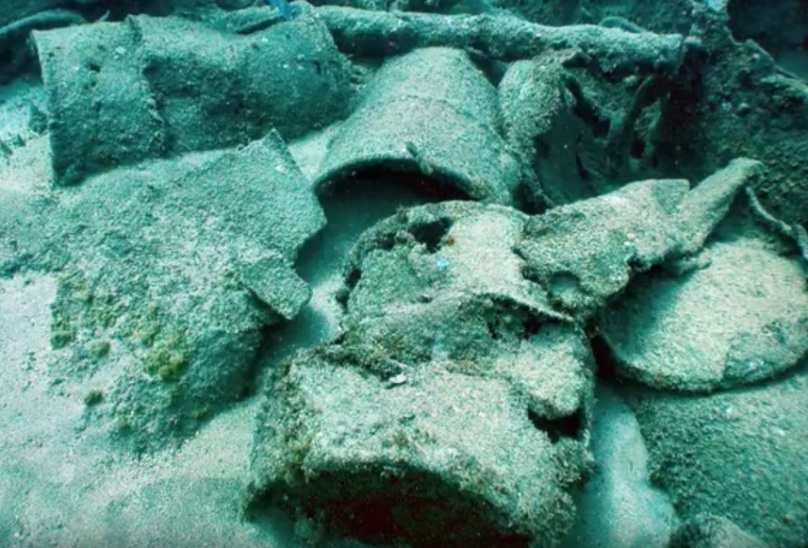
Starting in the late 1990s, the US Navy offered contradictory answers as to what was in the barrels, including cement, sand, or nothing at all. In retrospect it appears that by then the US Navy itself didn’t know any longer, and was just guessing.
During the Cold War, it wasn’t uncommon to use 55 gallon drums on target hulks; either to compensate for stripped equipment; or; as a flotation aid. Below is a snippet from the Hardtack I report; this technique was used on the Liberty Ship even then.
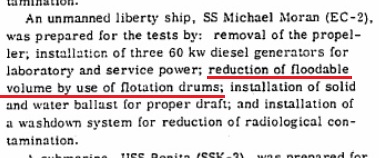
It’s likely that the barrels on the ex-Killen were used for both purposes. With the superstructure, masts, and gun turrets stripped off; the hulk’s centre-of-gravity would have shifted significantly and the “full” barrels were probably used as ballast. Meanwhile, the “empty” barrels were possibly used to absorb kinetic energy from weapon hits. The “empty” barrels are also mostly found in areas less likely to be hit where they might serve as artificial buoyancy. Here, if a compartment flooded, air in the sealed barrels would counteract the flooding, and to a degree, fill the compartment preventing seawater ingress to begin with.
During the 2000s, one diver said he observed some barrels filled with swabs (navy mops) and rags, indicating they may be filled with radioactive cleaning debris. This was not observed in any later dives. Another diver stated that one barrel had “straws”, a recycling industry term for low-value cable cut into short lengths for easy shipping.
the “missing metal”
A related concern was that, even with the naked eye above, it was clear that the ex-Killen wreck is not a complete Fletcher class destroyer on the seafloor. Due to lazy journalism (1970s photos of the stripped hull were in the public realm), it was theorized that unlicensed salvors had cut pieces off the wreck over the years. As the public in Puerto Rico was also being led to believe that the ex-Killen was radioactive, this created a fear that radioactive steel was introduced into the island’s scrap industry.
Again, these fears were not completely paranoid. At roughly the same time in the late 1990s, it was discovered in Ukraine that unlicensed junkers were venturing into the exclusion zone from the defunct USSR’s 1986 disaster at Chernobyl, collecting radioactive scrap metal, and selling it.
unraveling the mystery
1983
In 1983 (while the Vieques range was still in heavy use), the US Navy notified the Commonwealth government in Puerto Rico of the wreck’s existence, and simply stated that it had served as a target hulk. No mention was made of the ship’s condition, nor that it had once served in the Pacific nuclear tests. No surveys of the wreck were allowed.
1999
In November 1999, Puerto Rico contracted the University of Georgia to study the sea around Vieques. It reported that there were two wrecks in the Bahia Salina del Sur area; one a WWII destroyer and the other what appeared to be a common barge. Both were full of barrels, and the sites were simply called “destroyer” and “barrel barge”.

(Brain Coral growing on what was then called the “barrel barge”, about 750′ away from the main wreck and pointed in a different direction.)
2001
In July 2001, immediately after President George W Bush announced the Vieques range would close, a private survey of the ex-Killen was made by the Agency for Toxic Substances & Disease Registry. It concentrated on sampling fish in the area. No ill effects were found.
2002
In September 2002, the US Navy issued a bland press release confirming that USS Killen had served as a target for nuclear tests; the first official mention of what was by then a widely-known fact.
In 2002, a company called Geo-Marine Inc was contracted by the US Navy to study the ex-Killen wreck. It found both port and starboard sides of the hull failed structurally, generally falling outwards. This resulted in a sort of “pancaking” effect. The bow is completely broken off the hull. The width of the wreckage is 71′, compared to the 39’8″ beam of a Fletcher class destroyer. However it is only 220′ long (compared to 376’6″), as the stern area is missing.

(The broken off lower portion of the bow laying on it’s starboard side.)
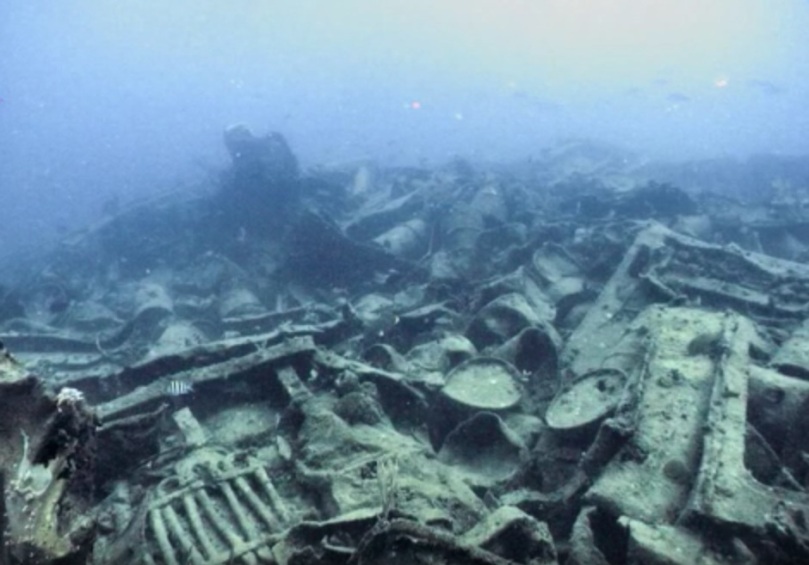
(Remains of the hull, looking aft to forward.)

(This tube was once a seawater main and not a WWII gun barrel as is sometimes stated. All weapons were off the ex-Killen no later than 1969 and probably before.)
The most intact item are the boilers, they are also oddly now the highest points above the seabed, due to the rest of the ship settling into the sand as the hull failed. Two of the four boilers normally aboard a Fletcher class are missing; presumably removed during the conversion into a target hulk. Both steam turbines are missing.
All topside features are gone, which was already more or less known from the US Navy’s photos. The Geo-Marine team determined that for whatever reason, all of the horizontal weather deck above the engineering spaces was removed before sinking, as no traces of it were found. Pieces of the deck once on the forward end of the destroyer, ahead of where the bridge had been, were found scattered and separated from the hull indicating that this portion at least still existed when the ship went to the bottom.
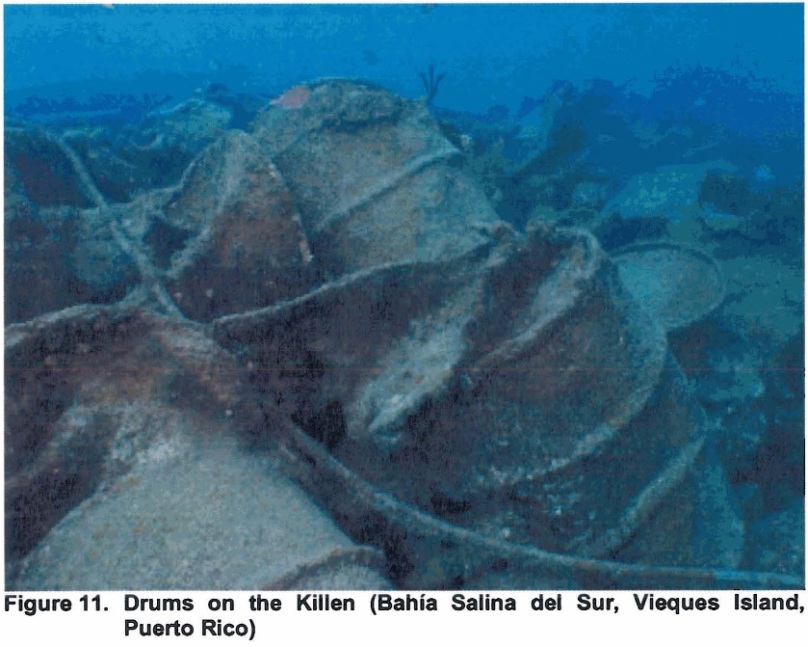
(photo via Geo-Marine)
The Geo-Marine team theorized that the “barrel barge” is actually the stern section of the ex-Killen. The team felt that about 111′ of the destroyer’s aft end is missing, while the “barrel barge” measures about 120′ in length. The 9′ difference might be due to both objects being distorted, and the difficulty in deciding where structural debris of both objects begins and ends. The beam (width at deck level) of the “barrel barge” exactly matches that of the Fletcher class at it’s fantail, where the depth charge racks had sat during WWII. No theory could be put forward as to why the stern end of the ex-Killen was catastrophically separated from the rest of the wreck.

(55 gallon drums inside the “barrel barge”.) (photo via Geo-Marine)

(Computer-enhanced image of the Fletcher class stern section, once thought to be the “barrel barge”.)
The 2002 Geo-Marine effort found no radiation, no contaminants, and no ill effects on either fish or coral on and around the wreck. The US Navy accepted Geo-Marine’s report as definitive and ended it’s interest in USS Killen.
2004
In 2003-2004, a Virginia-based company called Underwater Ordnance Recovery (UOR), in cooperation with the University of Georgia, was contracted by the Commonwealth of Puerto Rico’s Justice Department to again study the ex-Killen wreck. The reason this agency was involved was that if contamination was found, Puerto Rico planned to sue the federal government for it’s cleanup cost.
The UOR survey was perhaps the most thorough of all. In particular, special attention was paid to the 55 gallon drums. To begin, a general-purpose radiation dosimeter was clipped to several and left in place for 72 hours, this was to ensure that radiation inside (if present at all) would not be severe enough to endanger nearby scuba divers. The dosimeters found nothing. Next, a probe was used to puncture one of the drums to take a 15-minute measurement, and again, nothing was found.

(Three-day dosimeter clipped to one of the barrels.)
The UOR survey agreed with earlier estimations that the so-called “barrel barge” is in fact the stern section of the ex-Killen. It was apparently misnamed because it was so far from the rest of the wreck, and, because the curved stern of a Fletcher was mistaken for the round bow of a barge.

(The stern of the ex-Killen, once thought to be the bow of the “barrel barge”.) (photo via Geo-Marine)

(For comparison, the same section of USS Killen during WWII. The arched frame is a guard to protect the propeller from tugboats; it was probably removed at the same time as the propellers. The circles show WWII shipyard alterations, here changes to the stern and additional 20mm AA guns to fight the kamikaze threat. Compare the hawsehole on the deck edge with the 2000s photo above.)
Five different types of radiation detectors were used on the drums and in every case, no radiation above background levels was found. Clearly it was established that the drums had not been used to store radioactive material after the Hardtack I tests. No doubt this came as a relief to all involved.

A few of the drums which were filled, had a different-colored sand inside. It was proposed that this may have been terrestrial (ie, originally from dry land), while the rest had grey silt matching the seafloor in the area and were likely filled after the hulk sank. Some drums had what sailors call shell hash (very tiny seashells, as one might find on a beach); this could have been either put in before the sinking or washed into the drums afterwards.
The team tested for nine different isotopes associated with atomic fission. The only finding of remote interest was an elevated level of Cesium-137. This long-lived radioactive isotope was distributed worldwide as fallout from nuclear tests, starting with the Trinity test during WWII up to the ban on atmospheric testing in 1972. In the mid-1970s, Cesium-137 levels on Earth were at a peak and it stands to reason that the hulk would have taken this down with itself, either as terrestrial dirt inside the drums or as dust and mud on the vessel itself. By back-calculating the radioactive decay of Cesium, any which could have directly come from the Hardtack blasts is minimal or non-existent. Of the other isotopes, they were equal or less than background levels in 2004 or absent altogether.
After it was definitively shown that the barrels were not radioactive, the contents were tested for hazardous heavy metals, including lead, mercury, cadmium, and chromium. Lead was used in ammunition during both WWII and the Cold War, while the latter three metals were common in shipboard items during WWII. Nothing unexpected was found. In conclusion, the barrels were probably just used for ballast & buoyancy during the ex-Killen‘s career as a target, and were never a danger at all.
As for the wreck itself, one coral sample taken had increased levels of TNT and RDX. As countless bombs had been dropped in the area over the decades, it was unclear if the coral was leaching the contamination from the WWII ship’s hull, or, absorbing it from the general surrounding seawater. The UOR team found an unexploded 2000 lbs bomb near the wreck which was leaking chemicals used in naval explosive compositions. The team also theorized that there was a great deal more UXO laying just under the seafloor silt. No ordnance of any type was found on the ex-Killen itself. No radiation was detected on the hull.

(Looking aft in what was once the forward port side bilge.)
A pressurized gas cylinder was found aboard the wreck, intact with it’s valve rusted in the shut position. The divers did not attempt to study it further as they didn’t know what was inside.

UOR’s final conclusion, issued in March 2004, was that the ex-Killen presented minimal to no environmental danger and should be left alone as it is now serving as an artificial reef for sea life.
Postscript
Unfortunately the various studies and surveys have not fully stopped the media panic regarding the wreck, especially in Puerto Rico. Some of this is no doubt just sloppy journalism, but given the thorough way the wreck had been studied by the mid-2000s, it’s hard to believe that at least some of it is not willful mistruths or sensationalism.
A 2009 eco-activist press release still said that the ex-Killen was a “radioactive battleship”. As recently as 2010, some news outlets in Puerto Rico were conflating general UXO around the former range, such as Vietnam War-era 500lbs bombs, as having spilled out of the ex-Killen.

(The ex-Killen in 1971.) (photo by Dick Lonhardt)
One legitimate grievance is the shocking lapse of records regarding USS Killen inbetween the Hardtack I tests in 1958 and the final turnover of Vieques in 2003. USS Killen was a commissioned destroyer which had once torpedoed a battleship in combat; not some nameless harbor scow or featureless buoy. The fact that the destroyer was later exposed to two nuclear detonations makes the lack of records all the more inexcusable. It is unacceptable that the vessel’s happenings for four and a half decades can barely be pieced together now. USS Killen basically fell into a bureaucratic black hole: after 1946 it was no longer a commissioned warship; after 1958, the destroyer was no longer attached to any mothballed reserve fleet; after 1963 it was no longer on the naval register – yet – not transferred to MARAD (US Maritime Administration) civilian custody, nor disposed of; and after 1965 it was not an uncommissioned afloat asset like a barge, nor a was it technically a ship any longer. It was basically a piece of property of Roosevelt Roads naval station, little different from an audit standpoint than an office typewriter or barracks bunk.
If the US Navy’s strategy was to rely on the records of contracted civilian companies, the disappearance of Andy International served to show that as an error.
It is difficult to say how many other WWII ships, either involved in the 1940s-1960s nuclear test program or not, are in a similar record-keeping limbo.


Reblogged this on Brittius.
LikeLike
Anyone ever go down to the wreck with, I dunno, A GEIGER COUNTER? Or some unexposed film?
Seems like that could answer a lot of questions.
Small world, I used to work at Geo-Marine. Although for the first 6 months I thougt it was G-O Marine. ‘later-seeya-bye-GOOD!’
LikeLike
Yes as mentioned in the article they used five different types of geigers, looking for alpha, beta, gamma, and fission byproducts.
LikeLike
My name is Templeton Briggs III. Tory.Briggs@yahoo.com.
I was part of the crew that cut up the Killen at Roosevelt Roads in early 1975.
Missing from the history is:
It was filled keel to deck with high density polyurethane foam, in Houston, before being used as a target.
The deck was 3/4″ armor plate BTW.
We were only after the valuable condenser tubes and massive seawater valves. I think my boss paid $25k for her.
We cleared most everything off the deck, almost rolled our big truck pulling a piece off.
We used a water blaster at 10k psi to break up the foam, pumped in seawater, basketed out the pieces, pumped it dry and cut out the exposed stuff.
I speak Spanish, so I drove and bought stuff for the work or worked on the fantasil sorting metal into 55 gallon drums. One day, for fun, I ran the water blaster. Missing a toe on my left foot when a beam that had been cut on both ends but was supported by cable bundles in the foam, collapsed.
The boss blew too much money on a roulette scene in Monaco and the project ended incomplete (met him while at MIT, he was very clever). I was left stranded in the navy hospital, got out in a month, ended up living there for a couple years.
Note, navy divers tried to scuttle the ship before we got our hands on it, the 12′ and 20′ blown out sections of the keel didn’t work, the foam held it together.
I suspect the navy filled the hulk with old 55 gall drums, towed it out, and blew the stern off to sink it. There were piles of drums all over that base.
The drydock was huge, it’s crane rested on four rr flatbeds, its control room was six flights of stairs up (shown in one of the pictures). When there were no sharks in the filled dry dock, I and one other jumped off it a few times.
LikeLiked by 1 person
Thank you 100% for this; it is amazing to actually connect with somebody actually involved in the thing I wrote about! Thank you again for sharing this history.
LikeLike
I have some pictures of the foam mess inside a turbine bay.
LikeLiked by 1 person
I’m interested in the 1947 defeat of operation Highjump. Not the cover story. What brought down the Corsair fighters and sank the ship? What atmospheric psycological weapons were used on the USN by the Nazis? What effect did the invisible forcefield protecting their base in antarctica have on USN aircraft flying into it?
LikeLike
Are we looking at the same article? The word geiger comes up twice when i search, my comment and yours. Course, now it will come up three times.
LikeLike
Bobo: A geiger counter is simply a type of Dosimeter, which is mentioned as well as stating several times that there was no radiation detected – it doesn’t state specifically what device was used, could have been a geiger counter. Rest assured, the fact that you didn’t know what a Dosimeter is means that smarter people were investigating the wreck.
LikeLike
great research, i really like your blog!
LikeLiked by 1 person
Got to say that I am really impressed with these series of articles. They appear well researched and factual. In particular I like the unusual details that are noted, for example, in this story, the replacement of the propellers with flat discs. Apart from all that, they are really cool articles that I don’t believe anyone else has done before. On an aside, it’s disappointing the USN chose an historic ship like the Killen for such a sad and unrewarding career. I’m sure they could have found a vessel with less fame.
Anyway, please continue your great work. I’m sure I’m not the only one that enjoys these articles immensely.
LikeLiked by 1 person
Great article, I have been following this ships history since seeing areal photos showing images of the wreck. You have compiled the most informative essay I have seen, and I will bookmark it.
Any information on regulations regarding diving the wreck? I have seen a few YouTube videos on dives, but all warn of UXO in the area.
LikeLiked by 1 person
As far as I know, it is still off-limits to general scuba. The formed US Navy areas are now controlled by P.R.’s Fish & Wildlife Service. From what I gather (and I may be wrong) the local boats on the island won’t take you directly above the wreck, but, if you can find a boat on the main island who agrees to, they will. Of course if you own your own boat or know somebody personally, they will. I think the concerns are not UXO but people damaging the reefs.
LikeLike
Neat article. I like how you trace the history and piece together what happened – this must have taken a long time to research and write. Thanks for the effort!
LikeLiked by 1 person
As a son of a Killen Alumni, I have followed this ships history since childhood. This article is perhaps the most complete I’ve ever seen. Aside from personal stories handed down to me by my dad, this published history is very helpful as a chronology. It is fascinating there are so many holes in the Killens life post WWII. Especially puzzling to me is how the stern ended up so far from the main debris. This was a gallant warship that found a very different life wall after her gums ceased. Most of these tin cans were scrapped yet we still can see this ships remains in shallow water of Vieques. A local dive shop will take a divers or Snorkellers to this sight weather permitting. I intend to diver this WWII ship. My dad experienced the battle of Battle of (surigao strait) and the bomb blast days later that killed over a dozen men while on this DD. I’m pleased stories like these can live on for others to discover. Thx for this article.
LikeLike
As a son of a Killen Alumni, I have followed this ships history since childhood. This article is perhaps the most complete I’ve ever seen. Aside from personal stories handed down to me by my dad, this published history is very helpful as a chronology. It is fascinating there are so many holes in the Killens life post WWII. Especially puzzling to me is how the stern ended up so far from the main debris. This was a gallant warship that found a very different life well after her guns ceased. Most of these tin cans were scrapped yet we still can see this ships remains in shallow water of Vieques. A local dive shop will take divers or Snorkellers to this sight weather permitting. I intend to diver this WWII ship. My dad experienced the Battle of (surigao strait) and the bomb blast days later that killed over a dozen men while on this DD. I’m pleased stories like these can live on for others to discover. Thx for this article.
LikeLiked by 2 people
My father (Bob Jarnagin from Iowa) also was in the Killen and didn’t leave us many stories about the Killen – or the war. He did leave us several photos, including a few of Ominato, on leave in Honolulu, and of his time in Alaska before the Killen, with the names labelled. Anyone who has interest can write to me with your relative’s name to see if I have photos them to send you.
LikeLiked by 1 person
This is an amazing piece of research and writing — and I am very grateful for it! Thank you!
LikeLiked by 1 person
Jimmyrkenyon@aol.com
Hello SJ,
My father was John G Kenyon, served as electricians mate, gunners mate 40mm and also took pictures. Love to hear from you. Jim
LikeLike
So can we safely assume the test of spraying of internal clean water all over the outer part of the ship worked to absorb then “wash away” the radiation from atomic testing blast?. Otherwise, this thing would be hot, yes?
LikeLike
No actually. In the years following WWll, little was understood about rads. Most of the contaminated ships were sunk in very deep water after testing. Many men who worked on these ships developed illness as well. For some reason, the Killen was a ship that was spared a deep water burrial. It’s odd to me too as this ship had its bow badly damaged and many said she groaned and made noise after the repair. Most of these destroyers were scrapped esp if damaged. The Killen was scrapped and gutted I’m shallow water off Puerto Rico in the mid 70s. Locals were very upset the Navy allowed this and many rad tests were conducted. You can read the various test results. Most war ships had a short life. Many became famous in just months like Bismarck for instance. Killen has become historic long after her war relevants. That makes her especially interesting to me.
LikeLiked by 1 person
“Radioactive battleship” typical! Another great read.
LikeLiked by 1 person
Enjoyed reading this material. This was my dads WWII ship. I’d like to dive the wreck one day. Killen has one of the most curious post war histories. Very few Fletchers survived and only a few exist today. I saw an article RE: a law suit from a Pittsburgh company relative to the salvage of Killen. Would have been interesting to see the scuttling of the destroyer remains that day. One has to feel for the local PR residents so concerned about their island and fishing contamination worries. It always puzzled my why this vessel was sunk so close to shore and in such shallow water… unless it was for research purposes? Who knows.
LikeLiked by 1 person